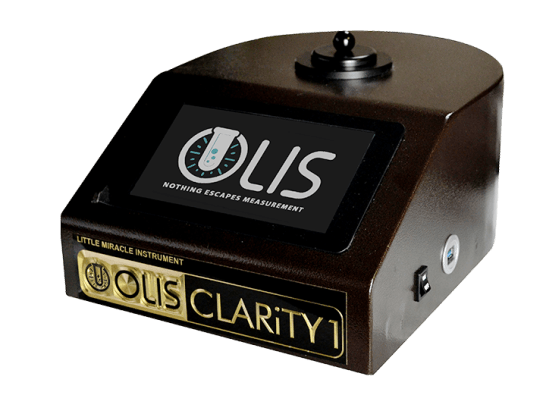Examine This Report on Circularly Polarized Luminescence
Table of ContentsSee This Report on Uv/vis/nirCircular Dichroism Fundamentals Explained4 Simple Techniques For Uv/visThe 30-Second Trick For SpectrophotometersUv/vis/nir for BeginnersSome Known Factual Statements About Circular Dichroism More About Uv/vis/nirSee This Report on Uv/vis10 Simple Techniques For SpectrophotometersFacts About Circular Dichroism RevealedThe Best Guide To Uv/vis/nirOur Uv/vis/nir StatementsSpectrophotometers for Beginners
It is then scanned through the sample and the reference services. Fractions of the event wavelengths are sent through, or shown from, the sample and the reference. The resultant light strikes the photodetector device, which compares the relative intensity of the 2 beams. Electronic circuits convert the relative currents into direct transmission percentages and/or absorbance/concentration worths.The transmission of a recommendation compound is set as a baseline (information) worth, so the transmission of all other compounds are recorded relative to the preliminary "zeroed" compound. The spectrophotometer then transforms the transmission ratio into 'absorbency', the concentration of specific elements of the test sample relative to the preliminary substance.
Since samples in these applications are not readily available in large quantities, they are especially matched to being analyzed in this non-destructive strategy. In addition, valuable sample can be conserved by making use of a micro-volume platform where just 1u, L of sample is required for total analyses. A short explanation of the procedure of spectrophotometry includes comparing the absorbency of a blank sample that does not include a colored substance to a sample which contains a colored compound.
The 25-Second Trick For Circular Dichroism
In biochemical experiments, a chemical and/or physical residential or commercial property is picked and the treatment that is utilized specifies to that home in order to obtain more information about the sample, such as the quantity, pureness, enzyme activity, etc. Spectrophotometry can be utilized for a number of techniques such as determining optimal wavelength absorbance of samples, figuring out optimum p, H for absorbance of samples, identifying concentrations of unknown samples, and identifying the p, Ka of numerous samples.: 21119 Spectrophotometry is likewise a valuable procedure for protein purification and can likewise be used as an approach to produce optical assays of a substance.
It is possible to know the concentrations of a two part mixture utilizing the absorption spectra of the standard solutions of each component. To do this, it is required to understand the termination coefficient of this mix at 2 wave lengths and the extinction coefficients of services which contain the known weights of the 2 parts.

Unknown Facts About Circularly Polarized Luminescence
The majority of spectrophotometers are utilized in the UV and visible regions of the spectrum, and some of these instruments also run into the near-infrared Area. The concentration of a protein can be approximated by measuring the OD at 280 nm due to the presence of tryptophan, tyrosine and phenylalanine (https://www.twitch.tv/olisclarity1/about).
Nucleic acid contamination can likewise interfere. This technique requires a spectrophotometer efficient in measuring in the UV region with quartz cuvettes.: 135 Ultraviolet-visible (UV-vis) spectroscopy includes energy levels that thrill electronic transitions. Absorption of UV-vis light delights particles that remain in ground-states to their excited-states. Visible area 400700 nm spectrophotometry is utilized thoroughly in colorimetry science.
These curves can be utilized to test a new batch of colorant to check if it makes a match to specifications, e
Traditional visible standard noticeable area not detect if spot colorant or the base material has fluorescence. This can make it tough to manage color problems if for example one or more of the printing inks is fluorescent. There are 2 significant setups for visual spectrum spectrophotometers, d/8 (spherical) and 0/45.
Researchers use this instrument to measure the quantity of substances in a sample. If the compound is more focused more light will be absorbed by the sample; within small ranges, the Beer, Lambert law holds and the absorbance in between samples differ with concentration linearly. In the case of printing measurements two alternative settings are typically used- without/with uv filter to manage better the effect of uv brighteners within the paper stock.
Facts About Circularly Polarized Luminescence Uncovered
Some applications require small volume measurements which can be carried out with micro-volume platforms. As explained in the applications area, spectrophotometry can be utilized in both qualitative and quantitative analysis of DNA, RNA, and proteins. Qualitative analysis can be used and spectrophotometers are utilized to tape-record spectra of substances by scanning broad wavelength regions to identify the absorbance properties (the intensity of the color) of the compound at each wavelength.

All about Uv/vis
One major factor is the kind of photosensors that are readily available for different spectral areas, but infrared measurement is also tough because practically everything gives off IR as thermal radiation, specifically at wavelengths beyond about 5 m. Another complication is that quite a couple of products such as glass and plastic take in infrared, making it incompatible as an optical medium.
Samples for IR spectrophotometry might be smeared in between two discs of potassium bromide or ground with potassium bromide and pushed into a pellet. Where aqueous options are to be determined, insoluble silver chloride is used to construct the cell. Spectroradiometers, which operate almost like the visible region spectrophotometers, are created to measure the spectral density of illuminants. Recovered Dec 23, 2018. Basic Laboratory Techniques for Biochemistry and Biotechnology (2nd ed.). The vital guide to analytical chemistry.
Chichester, NY: Wiley. pp. 1617. ISBN 9780471974123. OCLC 36543293. Ninfa AJ, Ballou DP (2004 ). Essential lab approaches for biochemistry and biotechnology. Hoboken: Wiley. p. 66. ISBN 9781891786006. OCLC 633862582. Rendina G (1976 ). Philadelphia, PA: W. B. Saunders Business. pp. 46-55. ISBN 0721675506. OCLC 147990. Oke, J. B.; Gunn, J. E.
The 9-Minute Rule for Circular Dichroism
"Secondary basic stars for outright spectrophotometry". The Astrophysical Journal. 266: 713. Bibcode:1983 Ap, J..266..713 O. doi:10. 1086/160817. Ishani, G (2006 ). "The first industrial UV-vis spectrophotometer". p. 100. Recovered Dec 23, 2018. Simoni, RD; Hill, RL; Vaughan, M; Tabor, H (Dec 5, 2003). "A Classic Instrument: The Beckman DU Spectrophotometer and Its Developer, Arnold O.
278 (49 ): e1. doi:. ISSN 1083-351X. Beckman, A. O.; Gallaway, W. S.; Kaye, W.; Ulrich, W. F. (March 1977). "History of spectrophotometry at Beckman Instruments, Inc". Analytical Chemistry. 49 (3 ): 280A300A. doi:10. 1021/ac50011a001. "Hewlett Packard: Compound Identification with HP 8450 A UV Noticeable Spectrophotometer". Analytical Chemistry. 51 (12 ): 1188A1189A. 1979-10-01.
1021/ac50048a728. ISSN0003-2700. Ninfa AJ, Ballou DP, Benore M (2015 ). Essential Lab Techniques for Biochemistry and Biotechnology (3, rev. ed.). Hoboken, NJ: Wiley & Sons. p. 77. ISBN9780470924525. OCLC915641828. "Fully Automatic Double Beam - Atomic Absorption Spectrophotometer (AA 8000)". Lab Devices. Labindia Analytical Instruments Pvt. Ltd. "Spectrophotometry Applications and Principles".
The Basic Principles Of Circular Dichroism
Retrieved Jul 4, 2018. Trumbo, Toni A.; Schultz, Emeric; Borland, Michael G.; Pugh, Michael Eugene (April 27, 2013). "Applied Spectrophotometry: Analysis of a Biochemical Mixture". Biochemistry and Molecular Biology Education. 41 (4 ): 24250. doi:10. 1002/bmb. 20694. PMID 23625877. (PDF). www. mt.com. Mettler-Toledo AG, Analytical. 2016. Recovered Dec 23, 2018. Cortez, C.; Szepaniuk, A.; Gomes da Silva, L.
"Checking Out Proteins Purification Methods Animations as Tools for the Biochemistry Teaching". Journal of Biochemistry Education. 8 (2 ): 12. doi:. Garrett RH, Grisham CM (2013 ). Biochemistry. Belmont, CA: Cengage. p. 106. ISBN 978-1133106296. OCLC 801650341. Holiday, Ensor Roslyn (May 27, 1936). "Spectrophotometry of proteins". Biochemical Journal. 30 (10 ): 17951803. doi:10. 1042/bj0301795.
PMID 16746224. Hermannsson, Ptur G.; Vannahme, Christoph; Smith, Cameron L. C.; Srensen, Kristian T.; Kristensen, Anders (2015 ). "Refractive index dispersion sensing utilizing a range of photonic crystal resonant reflectors". Applied Physics Letters. 107 (6 ): 061101. Bibcode:2015 Ap, Ph, L. 107f1101H. doi:10. 1063/1. 4928548. S2CID 62897708. Mavrodineanu R, Schultz JI, Menis O, eds.
How Circularly Polarized Luminescence can Save You Time, Stress, and Money.
U.S. Department of Commerce National Bureau of Standards special publication; 378. Washington, D.C.: U.S. National Bureau of Standards. p. 2. OCLC 920079.
The process begins with a regulated light that brightens the examined sample. In the case of reflection, as this light communicates with the sample, some is taken in or released. The given off light travels to the detector, which is evaluated, quantified, and presented as industry-standard color scales and indices.
All terms are examined over the noticeable spectrum from 400 to 700 nm. In the case of transmission, when the light connects with the sample, it is either soaked up, shown, or transferred.
8 Easy Facts About Circularly Polarized Luminescence Shown
Examples consist of APHA (American Public Health Association) for watercolor and purity analysis, ASTM D1500 for petrochemical color analysis, edible oil indices used in food, and color analyses of beverages. The simplified mathematics looks like this:. Where T is the transmission coefficient. All terms are examined over the noticeable spectrum from 400 to 700 nm.
Image Credit: Matej Kastelic/ Dr. Arnold J. Beckman and his coworkers at the National Technologies Laboratories first invented the spectrophotometer in 1940. In 1935 Beckman established the business, and the discovery of the spectrophotometer was their most ground-breaking invention.
The Best Guide To Circularly Polarized Luminescence
99% accuracy. Over time, scientists kept enhancing the spectrophotometer style to improve its efficiency. For circumstances, the UV capabilities of the design B spectrophotometer were enhanced by changing the glass prism with a quartz prism. Ultimately, the Model DU was created, containing a hydrogen light and other enhancements. This instrument was used in industrial labs, centers, and chemistry and biochemistry departments.
After 1984, double-beam variations of the gadget were developed. The addition of external software with the arrangement of Extra resources onscreen screens of the spectra came in the 1990s. Generally, a spectrophotometer is comprised of 2 instruments, particularly, a spectrometer and a photometer. A fundamental spectrophotometer contains a source of light, a monochromator, a collimator for straight beam transmission, a cuvette to place a sample, and a photoelectric detector.
The Definitive Guide for Circularly Polarized Luminescence
There are various types of spectrophotometers in numerous shapes and sizes, each with its own function or performance. A spectrophotometer determines how much light is shown by chemical elements. circular dichroism. It determines the difference in light intensity based upon the total quantity of light presented to a sample and the amount of beam that passes through the sample service
As per the instrument's style, the sample is placed between the spectrometer and the photometer. After the light is travelled through the sample, the photometer measures its strength and shows the reading. A spectrophotometer is utilized to figure out the concentration of both colorless and colored solutes in a service. This instrument is utilized to figure out the rate of a reaction.